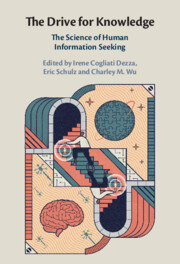Book contents
- The Drive for Knowledge
- The Drive for Knowledge
- Copyright page
- Contents
- Figures
- Tables
- Notes on Contributors
- Preface
- Part I What Drives Humans to Seek Information?
- Part II How Do Humans Search for Information?
- Chapter 5 What Makes a Good Query?
- Chapter 6 Active Inference, Bayesian Optimal Design, and Expected Utility
- Chapter 7 Exploration Beyond Bandits
- Chapter 8 Representational Exchange in Human Social Learning
- Part III Which Machinery Supports the Drive for Knowledge?
- Index
- References
Chapter 6 - Active Inference, Bayesian Optimal Design, and Expected Utility
from Part II - How Do Humans Search for Information?
Published online by Cambridge University Press: 19 May 2022
- The Drive for Knowledge
- The Drive for Knowledge
- Copyright page
- Contents
- Figures
- Tables
- Notes on Contributors
- Preface
- Part I What Drives Humans to Seek Information?
- Part II How Do Humans Search for Information?
- Chapter 5 What Makes a Good Query?
- Chapter 6 Active Inference, Bayesian Optimal Design, and Expected Utility
- Chapter 7 Exploration Beyond Bandits
- Chapter 8 Representational Exchange in Human Social Learning
- Part III Which Machinery Supports the Drive for Knowledge?
- Index
- References
Summary
Active inference, a corollary of the free energy principle, is a formal way of describing the behavior of certain kinds of random dynamical systems that have the appearance of sentience. In this chapter, we describe how active inference combines Bayesian decision theory and optimal Bayesian design principles under a single imperative to minimize expected free energy. It is this aspect of active inference that allows for the natural emergence of information-seeking behavior. When removing prior outcomes preferences from expected free energy, active inference reduces to optimal Bayesian design (i.e., information gain maximization). Conversely, active inference reduces to Bayesian decision theory in the absence of ambiguity and relative risk (i.e., expected utility maximization). Using these limiting cases, we illustrate how behaviors differ when agents select actions that optimize expected utility, expected information gain, and expected free energy. Our T-maze simulations show optimizing expected free energy produces goal-directed information-seeking behavior while optimizing expected utility induces purely exploitive behavior, and maximizing information gain engenders intrinsically motivated behavior.
- Type
- Chapter
- Information
- The Drive for KnowledgeThe Science of Human Information Seeking, pp. 124 - 146Publisher: Cambridge University PressPrint publication year: 2022
References
- 2
- Cited by



